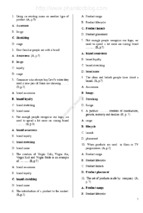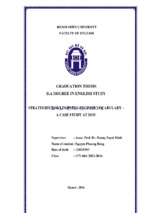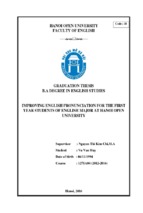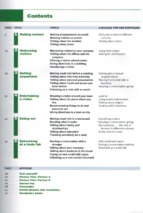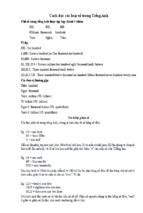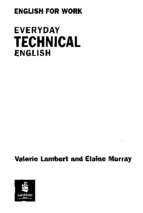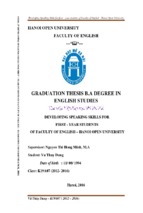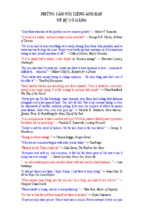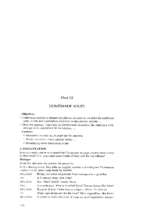visit the link to get test
Website : https://1001dethi.com/ dt 0909265875 .thầy phúc
SÁCH STARTERS :
Cụ thể : 1 bộ sách Starters 9 cuốn +audio listening
Trọn gói : 50.000Đ.
SÁCH MOVERS :
Cụ thể : 1 bộ sách Movers 9 cuốn + audio listening
Trọn gói : 50.000Đ.
SÁCH FLYERS :
Cụ thể : 1 bộ sách Flyers 9 cuốn +audio listening
Trọn gói : 50.000Đ
SÁCH KET :
Cụ thể : 1 bộ sách KET 10 cuốn +audio listening
Trọn gói : 50.000Đ
SÁCH PET :
Cụ thể : 1 bộ sách PET 8 cuốn +audio listening
Trọn gói : 40.000Đ
SÁCH Longman New Real Toeic (Trọn bộ 3 cuốn RC,LC và Full)
Trọn gói : 30.000Đ
1
1. Neutralisation /ˌnjuːtrəlaɪˈzeɪʃən/
2. In its simple form, the theory of the phoneme implies that two sounds that are in opposition to each other (e.g. t
and d in English) are in this relationship in all contexts throughout the language. Closer study of phonemes has,
however, shown that there are some contexts where the opposition no longer functions: for example, in a word
like ‘still’ stɪl, the t is in a position (following s and preceding a vowel) where voiced (lenis) plosives do not
occur. There is no possibility in English of the existence of a pair of words such as st ɪl and sd ɪl, so in this
context the opposition between t and d is neutralized. One consequence of this is that one could equally well
claim that the plosive in this word is a d, not a t. Common sense tells us that it is neither, but a different
phonological unit combining the characteristics of both. Some phonologists have suggested the word
‘archiphoneme’ for such a unit. The i vowel that we use to represent the vowel at the end of the word ‘happy’
could thus be called an archiphoneme.
3.
4. accent /ˈæksənt /
5. This word is used (rather confusingly) in two different senses:
6. (1) Accent may refer to prominence given to a syllable, usually by the use of pitch. For example, in the word
‘potato’ the middle syllable is the most prominent; if you say the word on its own you will probably produce a
fall in pitch on the middle syllable, making that syllable accented. In this sense, accent is distinguished from the
more general term stress, which is more often used to refer to all sorts of prominence (including prominence
resulting from increased loudness, length or sound quality), or to refer to the effort made by the speaker in
producing a stressed syllable.
7. (2) Accent also refers to a particular way of pronouncing: for example, you might find a number of English
speakers who all share the same grammar and vocabulary, but pronounce what they say with different accents
such as Scots or Cockney, or BBC pronunciation. The word accent in this sense is distinguished from dialect,
which usually refers to a variety of a language that differs from other varieties in grammar and/or vocabulary.
8. acoustic phonetics /əˌkuːstɪk fəˈnetɪks/
9. An important part of phonetics is the study of the physics of the speech signal: when sound travels through the
air from the speaker’s mouth to the hearer’s ear it does so in the form of vibrations in the air. It is possible to
measure and analyze these vibrations by mathematical techniques, usually by using specially-developed
computer software to produce spectrograms. Acoustic phonetics also studies the relationship between activity
in the speaker’s vocal tract and the resulting sounds. Analysis of speech by acoustic phonetics is claimed to be
more objective and scientific than the traditional auditory method which depends on the reliability of the
trained human ear.
10.
11.
articulator/ articulatory /articulation /ɑːˈtɪkjəleɪtə ɑːˈtɪkjələtəriɑːˌtɪkjəˈleɪʃən/
12.
The concept of the articulator is a very important one in phonetics. We can only produce speech sound
by moving parts of our body, and this is done by the contraction of muscles. Most of the movements relevant
to speech take place in the mouth and throat area (though we should not forget the activity in the chest for
breath control), and the parts of the mouth and throat area that we move when speaking are called
articulators. The principal articulators are the tongue, the lips, the lower jaw and the teeth, the velum or soft
palate, the uvula and the larynx. It has been suggested that we should distinguish between active articulators
(those which can be moved into contact with other articulators, such as the tongue) and passive articulators
which are fixed in place (such as the teeth, the hard palate and the alveolar ridge). The branch of phonetics
that studies articulators and their actions is called articulatory phonetics.
13.
14.
Adam’s apple /ˌædəmz ˈæpəl/
2
15.
This is an informal term used to refer to the pointed part of the larynx that can be seen at the front of
the throat. It is most clearly visible in adult males. Moving the larynx up and down (as in swallowing) causes
visible movement of this point, which is in fact the highest point of the thyroid cartilage.
16.
17.
advanced /ədˈvɑːntst/
18.
The International Phonetic Alphabet gives a diacritic [ ̟ ] for “advanced”, which makes it possible to
indicate that a vowel is produced with the tongue further forward in the mouth than another vowel with which
it may be compared. Thus [ɑ̟] indicates an advanced open vowel that is further forward than [ɑ]. The term
“advanced” is also used of the position of the tongue root: in a number of the world’s languages there are
pairs or sets of vowels which are said to differ from each other in that one vowel has the tongue root
advanced (that is, moved forward) in relation to another vowel. Such a vowel is said to have the feature
Advanced Tongue Root (ATR). This is difficult to establish, and we have to use special equipment to
demonstrate it.
19.
20.
21.
affricate /ˈæfrɪkət/
22.
An affricate is a type of consonant consisting of a plosive followed by a fricative with the same place
of articulation: examples are the ʧ and ʤ sounds at the beginning and end of the English words ‘church’
/ʧɜːʧ/, ‘judge’ /ʤʌʤ/ (the first of these is voiceless, the second voiced). It is often difficult to decide
whether any particular combination of a plosive plus a fricative should be classed as a single affricate sound
or as two separate sounds, and the question depends on whether these are to be regarded as separate
phonemes or not. It is usual to regard ʧ, ʤ as affricate phonemes in English (usually symbolised č, ǰǰ by
American writers); ts, dz, tr, dr also occur in English but are not usually regarded as affricates. The two
phrases ‘why choose’ waɪ ʧuːz and ‘white shoes’ waɪt ʃuːz are said to show the difference between the ʧ
affricate (in the first example) and separate t and ʃ (in the second).
23.
24.
airstream /ˈeəstriːm/
25.
26.
All speech sounds are made by making air move. Usually the air is moved outwards from the body,
creating an egressive airstream; more rarely, speech sounds are made by drawing air into the body – an
ingressive airstream. The most common way of moving air is by compression of the lungs so that the air is
expelled through the vocal tract. This is called a pulmonic airstream (usually an egressive pulmonic one, but
occasionally speech is produced while breathing in). Others are the glottalic (produced by the larynx with closed
vocal folds; it is moved up and down like the plunger of a bicycle pump) and the velaric (where the back of the
tongue is pressed against the soft palate, or velum, making an air-tight seal, and then drawn backwards or
forwards to produce an airstream). Ingressive glottalic consonants (often called implosives) and egressive ones
(ejectives) are found in many non-European languages; click sounds (ingressive velaric) are much rarer, but
occur in a number of southern African languages such as Nàmá, Xhosa and Zulu. Speakers of other languages,
including English, use click sounds for non-linguistic communication, as in the case of the “tut-tut” (American
“tsk-tsk”) sound of disapproval.
27.
28.
29.
allophone /ˈæləfəʊn/
30.
31.
Central to the concept of the phoneme is the idea that it may be pronounced in many different ways.
In English (BBC pronunciation) we take it for granted that the r sounds in ‘ray’ and ‘tray’ are “the same sound”
(i.e. the same phoneme), but in reality the two sounds are very different – the r in ‘ray’ is voiced and nonfricative, while the r sound in ‘tray’ is voiceless and fricative. In phonemic transcription we use the same symbol
r for both, but we know that the allophones of r include the voiced non-fricative sound ɹ and the voiceless
fricative one ʂ.
3
32.
33.
In theory a phoneme can have an infinite number of allophones, but in practice for descriptive
purposes we tend to concentrate on a small number that occur most regularly.
34.
35.
alveolar /ˌælviˈəʊlə/
36.
37.
Behind the upper front teeth there is a hard, bony ridge called the alveolar ridge; the skin covering it is
corrugated with transverse wrinkles. The tongue comes into contact with this in some of the consonants of
English and many other languages; sounds such as t, d, s, z, n, l are consonants with alveolar place of
articulation.
38.
alveolo-palatal /ˌælviəʊləʊ ˈpælətəl/
39.
40.
When we look at the places of articulation used by different languages, we find many differences in
the region between the upper teeth and the front part of the palate. It has been proposed that there is difference
between alveolo-palatal and palato-alveolar that can be reliably distinguished, though others argue that factors
other than place of articulation are usually involved, and there is no longer an alveolo-palatal column on the
IPA chart. The former place is further forward in the mouth than the latter: the usual example given for a
contrast between alveolo-palatal and palato-alveolar consonants is that of Polish ɕ and ʃ as in ‘Kasia’ ka ɕa and
‘kasza’ kaʃa.
41.
42.
ambisyllabic /ˌæmbisɪˈlæbɪk/
43.
44.
We face various problems in attempting to decide on the division of English syllables: in a word like
‘better’ betə the division could be (using the . symbol to mark syllable divisions) either be.tə or bet.ə, and we
need a principle to base our decision on. Some phonologists have suggested that in such a case we should say
that the t consonant belongs to both syllables, and is therefore ambisyllabic; the analysis of ‘better’ betə is then
that it consists of the syllables bet and tə.
45.
46.
anterior /ænˈtɪəriə/
47.
48.
In phonology it is sometimes necessary to distinguish the class of sounds that are articulated in the
front part of the mouth (anterior sounds) from those articulated towards the back of the mouth. All sounds
forward of palato-alveolar are classed as anterior.
49.
apical /ˈæpɪkəl/
50.
51.
Consonantal articulations made with the tip of the tongue are called apical; this term is usually
contrasted with laminal, the adjective used to refer to tongue-blade articulations. It is said that English s is
usually articulated with the tongue blade, but Spanish s (when it occurs before a vowel) and Greek s are said to
be apical, giving a different sound quality.
52.
53.
approximant /əˈprɒksɪmənt/
54.
55.
This is a phonetic term of comparatively recent origin. It is used to denote a consonant which makes
very little obstruction to the airflow. Traditionally these have been divided into two groups: “semivowels” such
as the w in English ‘wet’ and j in English ‘yet’, which are very similar to close vowels such as [u] and [i] but
4
are produced as a rapid glide; and “liquids”, sounds which have an identifiable constriction of the airflow but
not one that is sufficiently obstructive to produce fricative noise, compression or the diversion of airflow
through another part of the vocal tract as in nasals. This category includes laterals such as English l in ‘lead’
and non-fricative r (phonetically ɹ) in ‘read’. Approximants therefore are never fricative and never contain
interruptions to the flow of air.
56.
articulatory setting /ɑːˌtɪkjələtəri ˈsetɪŋ/
57.
58.
This is an idea that has an immediate appeal to pronunciation teachers, but has never been fully
investigated. The idea is that when we pronounce a foreign language, we need to set our whole speechproducing apparatus into an appropriate “posture” or “setting” for speaking that language. English speakers
with a good French accent, for example, are said to adjust their lips to a more protruded and rounded shape
than they use for speaking English, and people who can speak several languages are claimed to have different
“gears” to shift into when they start saying something in one of their languages.
59.
60.
See also voice quality.
61.
arytenoids /ˌærɪˈtiːnɔɪdz/
62.
63.
Inside the larynx there is a tiny pair of cartilages shaped rather like dogs’ ears. They can be moved in
many different directions. The rear ends of the vocal folds are attached to them so that if the arytenoids are
moved towards each other the folds are brought together, making a glottal closure or constriction, and when
they are moved apart the folds are parted to produce an open glottis. The arytenoids contribute to the
regulations of pitch: if they are tilted backwards the vocal folds are stretched lengthwise (which raises the pitch
if voicing is going on), while tilting them forwards lowers the pitch as the folds become thicker.
64.
aspiration /ˌæspəˈreɪʃən/
65.
66.
This is noise made when a consonantal constriction is released and air is allowed to escape relatively
freely. English p t k at the beginning of a syllable are aspirated in most accents so that in words like ‘pea’, ‘tea’,
‘key’ the silent period while the compressed air is prevented from escaping by the articulatory closure is
followed by a sound similar to h before the voicing of the vowel begins. This is the result of the vocal folds
being widely parted at the time of the articulatory release. It is noticeable that when p t k are preceded by s at
the beginning of a syllable they are not aspirated. Pronunciation teachers used to make learners of English
practise aspirated plosives by seeing if they could blow out a candle flame with the rush of air after p t k – this
can, of course, lead to a rather exaggerated pronunciation (and superficial burns). A rather different articulation
is used for so-called voiced aspirated plosives found in many Indian languages (often spelt ‘bh’, ‘dh’, ‘gh’ in
the Roman alphabet) where after the release of the constriction the vocal folds vibrate to produce voicing, but
are not firmly pressed together; the result is that a large amount of air escapes at the same time, producing a
“breathy” quality.
67.
68.
It is not necessarily only plosives that are aspirated: both unaspirated and aspirated affricates are
found in Hindi, for example, and unaspirated and aspirated voiceless fricatives are found in Burmese.
69.
70.
See also voice onset time (VOT)
71.
assimilation /əˌsɪmɪˈleɪʃən/
72.
73.
If speech is thought of as a string of sounds linked together, assimilation is what happens to a sound
when it is influenced by one of its neighbours. For example, the word ‘this’ has the sound s at the end if it is
pronounced on its own, but when followed by ʃ in a word such as ‘shop’ it often changes in rapid speech
5
(through assimilation) to ʃ, giving the pronunciation ðɪʃʃɒp. Assimilation is said to be progressive when a
sound influences a following sound, or regressive when a sound influences one which precedes it; the most
familiar case of regressive assimilation in English is that of alveolar consonants, such as t, d, s, z, n, which are
followed by non-alveolar consonants: assimilation results in a change of place of articulation from alveolar to a
different place. The example of ‘this shop’ is of this type; others are ‘football’ (where ‘foot’ fuːt and ‘ball’ bɔːl
combine to produce fuːpbɔːl) and ‘fruit-cake’ (fruːt + keɪk → fruːkkeɪk). Progressive assimilation is
exemplified by the behaviour of the ‘s’ plural ending in English, which is pronounced with a voiced z after a
voiced consonant (e.g. ‘dogs’ dɒɡz) but with a voiceless s after a voiceless consonant (e.g. ‘cats’ kæts).
74.
75.
The notion of assimilation is full of problems: it is often unhelpful to think of it in terms of one sound
being the cause of the assimilation and the other the victim of it, when in many cases sounds appear to
influence each other mutually; it is often not clear whether the result of assimilation is supposed to be a
different allophone or a different phoneme; and we find many cases where instances of assimilation seem to
spread over many sounds instead of being restricted to two adjacent sounds as the conventional examples
suggest. Research on such phenomena in experimental phonetics does not usually use the notion of
assimilation, preferring the more neutral concept of coarticulation.
76.
attitude/attitudinal /ˈætɪʧuːd ˌætɪˈʧuːdɪnəl/
77.
78.
Intonation is often said to have an attitudinal function. What this means is that intonation is used to
indicate to the hearer a particular attitude on the part of the speaker (e.g. friendly, doubtful, enthusiastic).
Considerable importance has been given by some language teaching experts to learning to express the right
attitudes through intonation, but it has proved extremely difficult to state usable rules for foreigners to learn and
results have often been disappointing. It has also proved very difficult to design and carry out scientific studies
of the way intonation conveys attitudes and emotions in normal speech.
79.
auditory /ˈɔːdɪtəri/
80.
81.
When the analysis of speech is carried out by the listener’s ear, the analysis is said to be an auditory
one, and when the listener’s brain receives information from the ears it is said to be receiving auditory
information. In practical phonetics, great importance has been given to auditory training: this is sometimes
known as ear-training, but in fact it is the brain and not the ear that is trained. With expert teaching and regular
practice, it is possible to learn to make much more precise and reliable discriminations among speech sounds
than untrained people are capable of. Although the analysis of speech sounds by the trained expert can be
carried out entirely auditorily, in most cases the analyst also tries to make the sound (particularly when working
face to face with a native speaker of the language or dialect), and the proper name for this analysis is then
auditory-kinaesthetic.
82.
autosegmental phonology /ˌɔːtəʊseɡˌmentəl fəˈnɒləʤi/
83.
84.
One fairly recent development in phonology is one which attempts to separate out the phonological
material of an utterance into components on different levels. For example, if we give a fall–rise intonation
pattern to the following two utterances:
85.
86.
\/ some and \/ some of them
87.
88.
the pitch movement is phonologically the same object in both cases, but stretches over a longer
sequences of syllables in the second case. We can make up similar examples in terms of rhythm, using the unit
of the foot, and autosegmental phonology is closely linked to metrical phonology.
89.
90.
Although this is an approach that was mainly developed in the 1990s in America, it is very similar to
the Prosodic Phonology proposed by J. R. Firth and his associates at the School of Oriental and African Studies
of London University in the 1940s and 50s.
6
91.
back(ness) /bæk ˈbæknəs/
92.
93.
A back vowel is one which is produced with the back of the tongue raised. Among the cardinal
vowels, the following are the back vowels: [ɑ, ɒ, ʌ, ɔ, ɤ, o, ɯ, u].
94.
BBC pronunciation /ˌbiːbiːˌsiː prənʌntsiˈeɪʃən/
95.
96.
The British Broadcasting Corporation is looked up to by many people in Britain and abroad as a
custodian of good English; this attitude is normally only in respect of certain broadcasters who represent the
formal style of the Corporation, such as newsreaders and announcers, and does not apply to the more informal
voices of people such as disc-jockeys and chat-show presenters (who may speak as they please). The high
status given to the BBC’s voices relates both to pronunciation and to grammar, and there are listeners who write
angry letters to the BBC or the newspapers to complain about “incorrect” pronunciations such as “loranorder”
for “law and order”. Although the attitude that the BBC has a responsibility to preserve some imaginary pure
form of English for posterity is extreme, there is much to be said for using the “formal” BBC accent as a model
for foreign learners wishing to acquire an English accent. The old standard “Received Pronunciation (RP)” is
based on a very old-fashioned view of the language; the present-day BBC accent is easily accessible and easy
to record and examine. It is relatively free from class-based associations and it is available throughout the
world where BBC broadcasts can be received; however, in recent years, the Overseas Service of the BBC has
taken to using a number of newsreaders and announcers who are not native speakers of English and have what
is, by British standards, a foreign accent. The BBC nowadays uses quite a large number of speakers from Celtic
countries (particularly Ireland, Scotland and Wales), and the description of “BBC Pronunciation” should not be
treated as including such speakers.
97.
98.
The Corporation has its own Pronunciation Research Unit, but contrary to some people’s belief its
function is to advise on the pronunciation of foreign words and of obscure British names and not to monitor
pronunciation standards. Broadcasters are not under any obligation to consult the Unit.
99.
binary /ˈbaɪnəri/
100.
101.
Phonologists like to make clear-cut divisions between groups of sounds, and usually this involves
“either-or” choices: a sound is eithervoiced or voiceless, consonantal or non-consonantal, rounded or
unrounded. Such choices are binary choices. In the study of phonetics, however, it is acknowledged that sounds
differ from each other in “more or less” fashion rather than “either-or”: features like voicing, nasality or
rounding are scalar or multi-valued, and a sound can be, for example, fully voiced, partly voiced, just a little bit
voiced or not voiced at all.
102.
103.
When distinctive features of sounds are given binary values, they are usually marked with the plus
and minus signs + and −, so a voiced consonant is classed as +voice and a voiceless one as −voice.
104.
blade /bleɪd/
105.
106.
For the purposes of articulatory description, the tongue is divided into a number of regions or parts.
The blade of the tongue is the area next to the tip, and is used in the production of alveolar consonants such as
[t, d, s, z].
107.
boundary /ˈbaʊndəri/
108.
109.
The notion of the boundary is very important in phonetics and phonology. At the segmental level, we
need to know where one segment ends and another begins, and this can be a difficult matter: in a word like
‘hairier’ heəriə, which contains no plosives or fricatives, each sound seems to merge gradually into the next. In
dividing words into syllables we have many difficulties, resulting in ideas like juncture and ambisyllabicity to
help us solve them. In intonation we have many different units at different levels, and dividing continuous
speech into tone-units separated by boundaries is one of the most difficult problems.
7
110.
brackets /ˈbrækɪts/
111.
112.
When we write in phonetic or phonemic transcription it is conventional to use brackets at the
beginning and end of the item or passage to indicate the nature of the symbols. Generally, slant brackets (also
known as “obliques”) are used to indicate phonemic transcription and square brackets for phonetic
transcription. For example, for the word ‘phonetics’ we would write /fənetiks/ (phonemic transcription) and
[fənetʰɪʔks] (phonetic transcription). However, in writing English Phonetics and Phonology I decided not to
use brackets in this way, apart from using square brackets when representing cardinal vowels, because I thought
that this would make the transcriptions easier to read, and that it would almost always be obvious which type of
transcription was being used in a given place.
113.
breath-group /ˈbreθ ˌɡruːp/
114.
115.
In order to carry out detailed analysis, linguists need to divide continuous speech into small,
identifiable units. In the present-day written forms of European languages, the sentence is an easy unit to work
with, and the full stop (“period” in American English) clearly marks its boundaries. It would be helpful if we
could identify something similar in spoken language and one possible candidate is a unit whose boundaries are
marked by the places where we pause to breathe: the breath-group. Unfortunately, although in the production of
isolated sentences and in very careful speech the places where a speaker will breathe may be quite predictable,
in natural speech such regularity disappears, so that the breath-group can vary very greatly in terms of its length
and its relationship to linguistic structure. It is, consequently, little used in modern phonetics and linguistics.
116.
breathing /ˈbriːðɪŋ/
117.
118.
This is the movement of air into and out of the lungs. Speech is something which is imposed on
normal breathing, resulting in a reduced rate of airflow out of the body. Mostly the air pressure that pushes air
out and allows us to produce speech sounds is caused by the chest walls pressing down on the lungs, but we
can give the air an extra push with the diaphragm, a large sheet of muscle lying between the lungs and the
stomach.
119.
breathy /ˈbreθi/
120.
121.
This is one of the adjectives used to describe voice quality or phonation type. In breathy voice, the
vocal folds vibrate but allow a considerable amount of air to escape at the same time; this adds “noise” (similar
to loud breathing) to the sound produced by the vocal folds. It is conventionally thought that breathy voice
makes women’s voices sound attractive, and it is used by speakers in television advertisements for “soft”
products like toilet paper and baby powder.
122.
burst /bɜːst/
123.
124.
When a plosive (such as English p, t, k, b, d, ɡ) is released while air is still compressed within the
vocal tract, the air rushes out with some force. The resulting sound is usually referred to as plosion in general
phonetic terminology, but in acoustic phonetics it is more common to refer to this as a burst. It is usually very
brief – somewhere around a hundredth of a second.
125.
cardinal vowel /ˌkɑːdɪnəl ˈvaʊə l/
126.
127.
Phoneticians have always needed some way of classifying vowels which is independent of the vowel
system of a particular language. With most consonants it is quite easy to observe how their articulation is
organized, and to specify the place and manner of the constriction formed; vowels, however, are much less easy
to observe. Early in the 20th century, the English phonetician Daniel Jones worked out a set of “cardinal
vowels” that students learning phonetics could be taught to make and which would serve as reference points
that other vowels could be related to, rather like the corners and sides of a map. Jones was strongly influenced
by the French phonetician Paul Passy, and it has been claimed that the set of cardinal vowels is rather similar to
the vowels of educated Parisian French of the time.
8
128.
129.
From the beginning it was important to locate the vowels on a chart or four-sided figure (the exact
shape of which has changed from time to time), as can be seen on the IPA chart. The cardinal vowel diagram is
used both for rounded and unrounded vowels, and Jones proposed that there should be a primary set of cardinal
vowels and a secondary set. The primary set includes the front unrounded vowels [ɪ, e, ɛ, a], the back
unrounded vowel [ɑ] and the rounded back vowels [ɔ, o, u], while the secondary set comprises the front
rounded vowels [y, ø, œ, ɶ], the back rounded [ɒ] and the back unrounded [ʌ, ɤ, ɯ]. For the sake of
consistency, I believe it would be better to abandon the “primary/secondary” division and simply give a
“rounded” or “unrounded” label (as appropriate) to each vowel on the quadrilateral.
130.
131.
Phonetic “ear-training” makes much use of the cardinal vowel system, and students can learn to
identify and discriminate a very large number of different vowels in relation to the cardinal vowels.
132.
cartilage /ˈkɑːtɪlɪʤ/
133.
134.
Many parts of the body used in speech are made of cartilage, which is less hard than bone. In
particular, the structure of the larynx is largely made of cartilage, though as we get older some of this turns to
bone.
135.
centre/central /ˈsentə ˈsentrəl/
136.
137.
A vowel is central if it is produced with the central part of the tongue raised (i.e. it is neither front like
[i] nor back like [u]). All descriptions of vowel quality recognise a vowel that is both central (i.e. between front
and back) and mid (i.e. half-way between close and open), usually named schwa (for which the symbol is [ə] ).
Phonetic symbols exist also for central vowels which are close - either rounded [ ʉ] or unrounded [ ɨ] – and for
open-mid to open unrounded [ɐ], as well as close-mid and open-mid (see the IPA chart). Apart from the symbol
used for the English vowel in ‘fur’ [ɜ] these are little used.
138.
chart /ʧɑːt/
139.
140.
It is usual to display sets of phonetic symbols on a diagram made of a rectangle divided into squares,
usually called a chart, but sometimes called a matrix or a grid. The best-known phonetic chart is that of the
alphabet of the International Phonetic Association – the IPA chart. On this chart the vertical axis represents the
manner of articulation of a sound (e.g. plosive, nasal) and the horizontal axis represents the place of articulation
(e.g. bilabial, velar). Within each box on the chart it is possible to have two symbols, of which the left hand one
will be voiceless and the right hand voiced. A number of charts are given in English Phonetics and Phonology;
the IPA chart is printed on page xii.
141.
chest-pulse /ˈʧest ˌpʌls/
142.
143.
This is a notion used in the theory of syllable production. Early in the twentieth century it was
believed by some phoneticians that there was a physiological basis to the production of syllables: experimental
work was claimed to show that for each syllable produced, there was a distinct effort, or pulse, from the chest
muscles which regulate breathing. It is now known that chest-pulses are not found for every syllable in normal
speech, though there is some evidence that there may be chest-pulses for stressed syllables.
144.
clear l /ˌklɪər ˈel/
145.
146.
This is a type of lateral sound (such as the English l in ‘lily’), in which the air escapes past the sides of
the tongue. In the case of an alveolar lateral (e.g. English l) the blade of the tongue is in contact with the
alveolar ridge, but the rest of the tongue is free to take up different shapes. One possibility is for the front of the
tongue (the part behind the blade) to be raised in the same shape as that for a close front vowel [i]. This gives
the l an [i]-like sound, and the result is a “clear l”. It is found in BBC English only before vowels, but in some
other accents, notably Irish and Welsh ones, it is found in all positions.
147.
9
148.
See also dark l.
149.
click /klɪk/
150.
151.
Clicks are sounds that are made within the mouth and are found as consonantal speech sounds in
some languages of Southern Africa, such as Xhosa (the name of which itself begins with a click) and Zulu.
Clicks are more familiar to English speakers as non-speech sounds such as the “tut-tut” or “tsk-tsk” sound of
disapproval. A different type of click sound (a lateral click) is (or was) used to make a horse move on, and also
for some social purposes such as expressing satisfaction. The way in which these sounds are made is for the
back of the tongue to make an air-tight closure against the back of the palate (see velaric airstream); an
articulatory closure is then made further forward in the mouth and those results in a completely sealed air
chamber within the mouth. The back of the tongue is then drawn backwards, which has the effect of lowering
the air pressure within the chamber so that if the forward articulatory closure is released quickly a plosive
sound is heard. There are many variations on this mechanism, including voicing, affricated release, and
simultaneous nasal consonant.
152.
clipped /klɪpt/
153.
154.
The term “clipped speech” has two meanings in the context of speech: in non-technical usage it refers
to a style of speaking often associated with military men and “horsey” people, characterised by unusually short
vowels; the term is also used in the study of speech acoustics to refer to a speech signal that has been distorted
in a particular way, usually through overloading.
155.
close vowel /ˌkləʊs ˈvaʊəl/
156.
157.
In a close vowel the tongue is raised as close to the palate as is possible without producing fricative
noise. Close vowels may be front (when the front of the tongue is raised), either unrounded [i] or rounded [y],
or they may be back (when the back of the tongue is raised), either rounded [u] or unrounded [ ɯ]. There are
also close central vowels: rounded [ʉ] and unrounded [ɨ]. English i and u are often described as close vowels,
but are rarely fully close in English accents.
158.
159.
See also open.
160.
closure /ˈkləʊʒə/
161.
162.
This word is one of the unfortunate cases where different meanings are given by different
phoneticians: it is generally used in relation to the production of plosive consonants, which require a total
obstruction to the flow of air. To produce this obstruction, the articulators must first move towards each other,
and must then be held together to prevent the escape of air. Some writers use the term closure to refer to the
coming together of the articulators, while others use it to refer to the period when the compressed air is held in.
163.
cluster /ˈklʌstə/
164.
165.
In some languages (including English) we can find several consonant phonemes in a sequence, with
no vowel sound between them: for example, the word ‘stray’ streɪ begins with three consonants, and ‘sixths’
sɪksθs ends with four. Sequences of two or more consonants within the same syllable are often called consonant
clusters. It is not usual to refer to sequences of vowels as vowel clusters.
166.
oalescence /ˈkəʊəlesənts/
167.
168.
Speech sounds rarely have clear-cut boundaries that mark them off from their neighbours. It
sometimes happens that adjacent phonemes slide together (coalesce) so that they seem to happen
simultaneously. An example is what is sometimes called yod-coalescence, where a sound preceding a j (“yod”)
becomes palatalised: thus the s at the end of ‘this’ can merge with the j of ‘year’ to give a pronunciation ð ɪʃʃɪə
or ðɪʃɪə.
169.
coarticulation /ˌkəʊɑːˌtɪkjəˈleɪʃən/
10
170.
171.
Experimental phonetics studies coarticulation as a way of finding out how the brain controls the
production of speech. When we speak, many muscles are active at the same time and sometimes the brain tries
to make them do things that they are not capable of. For example, in the word ‘Mum’ m ʌm the vowel phoneme
is one that is normally pronounced with the soft palate raised to prevent the escape of air through the nose,
while the two m phonemes must have the soft palate lowered. The soft palate cannot be raised very quickly, so
the vowel is likely to be pronounced with the soft palate still lowered, giving a nasalised quality to the vowel.
The nasalization is a coarticulation effect caused by the nasal consonant environment. Another example is the
lip-rounding of a consonant in the environment of rounded vowels: in the phrase ‘you too’, the t occurs
between two rounded vowels, and there is not enough time in normal speech for the lips to move from rounded
to unrounded and back again in a few hundredths of a second; consequently the t is pronounced with liprounding.
172.
173.
Coarticulation is a phenomenon closely related to assimilation; the major difference is that
assimilation is used as a name for the process whereby one sound becomes like another neighbouring sound,
while coarticulation, though it refers to a similar process, is concerned with articulatory explanations for why
the assimilation occurs, and considers cases where the changes may occur over a number of segments.
174.
cocktail party phenomenon /ˈkɒkteɪl ˌpɑːti fɪˌnɒmɪnən/
175.
176.
If you are at a noisy party with a lot of people talking close to you, it is a striking fact that you are
able to choose to listen to one person’s voice and to “shut out” what others are saying equally loudly. The
importance of this effect was first highlighted by the communications engineer Colin Cherry, and has led to
many interesting experiments by psychologists and psycholinguists. Cocktail parties are hard to find nowadays,
but you can simulate the effect by making someone wear headphones and playing simultaneous voices to them,
one in each ear, and asking them to concentrate on just one voice. The voices may be presented separately to
each ear (dichotic listening) or mixed together and played to both ears (binaural listening).
177.
coda /ˈkəʊdə/
178.
179.
This term refers to the end of a syllable. The central part of a syllable is almost always a vowel, and if
the syllable contains nothing after the vowel it is said to have no coda (“zero coda”). Some languages have no
codas in any syllables. English allows up to four consonants to occur in the coda, so the total number of
possible codas in English is very large – several hundred, in fact.
180.
commutation /ˌkɒmjuˈteɪʃən/
181.
182.
When we want to demonstrate that two sounds are in phonemic opposition, we normally do this with
the commutation test; this means substituting one sound for another in a particular phonological context. For
example, to prove that the sounds p, b, t, d are different contrasting phonemes we can try them one at a time in
a suitable context which is kept constant; using the context -n we get ‘pin’, ‘bin’, ‘tin’ and ‘din’, all of which
are different words.
183.
184.
There are serious theoretical problems with this test. One of them is the widespread assumption that if
you substitute one allophone of a phoneme for another allophone of the same phoneme, the meaning will not
change; this is sometimes true (substituting a “dark l” where a “clear l” is appropriate in BBC pronunciation,
for example, is unlikely to change a perceived meaning) but in other cases it is at least dubious: for example,
the unaspirated allophones of p, t, k found after s at the beginning of syllables such as sp, st, sk are phonetically
very similar to b, d, ɡ, and pronouncing one of these unaspirated allophones followed by -ɪl, for example,
would be likely to result in the listener hearing ‘bill’, ‘dill’, ‘gill’ rather than ‘pill’, ‘till’, ‘kill’.
185.
complementary distribution /ˌkɒmplɪˌmentəri ˌdɪstrɪˈbjuːʃən/
186.
11
187.
Two sounds are in complementary distribution if they never occur in the same context. A good
example is provided by the allophones of the l phoneme in BBC pronunciation: there is a voiceless allophone ɬ
when l occurs after p, t, k at the beginning of a syllable, “clear l” which occurs before vowels and “dark l”
which occurs elsewhere (i.e. before consonants or a pause). Leaving aside less noticeable allophonic variation,
these three allophones together account for practically all the different ways in which the l phoneme is realised;
since each of them has its own specific context in which it occurs, and does not occur in the contexts in which
the others occur, we can say that each is in complementary distribution with the others.
188.
189.
In conventional phoneme theory, sounds which are in complementary distribution are likely to belong
to the same phoneme; thus “voiceless l”, “clear l” and “dark l” in the example given above will be classed as
members of the same phoneme. There are problems in the argument, however: we can find quite a lot of sounds
in English, for example, which are in complementary distribution with each other but are still not considered
members of the same phoneme, a frequently quoted case being that of h (which cannot occur at the end of a
syllable) and ŋ (which cannot occur at the beginning of a syllable) – this forces us to say that sounds which are
in complementary distribution and are to be considered as allophones of the same phoneme must be
phonetically similar to each other (which h and ŋ clearly are not). But measuring phonetic similarity is itself a
very problematical area.
190.
connected speech /kəˌnektɪd ˈspiːʧ/
191.
192.
A lot of phonetic description is based on examination of small, isolated pieces of spoken material such
as syllables and words. However, it is necessary to look also at how these small components are pronounced
when a person is speaking naturally and producing continuous speech. The pronunciation of an item of speech
is often modified by factors such as rhythm, assimilation (or coarticulation), elision and linking, as well as by
speaking rate tempo) and situational factors such as the amount of background noise. The study of connected
speech is therefore a very important part of phonetics.
193.
consonant /ˈkɒntsənənt/
194.
195.
There are many types of consonant, but what all have in common is that they obstruct the flow of air
through the vocal tract. Some do this a lot, some not very much: those which make the maximum obstruction
(i.e. plosives, which form a complete stoppage of the airstream) are the most consonantal. Nasal consonants
result in complete stoppage of the oral cavity but are less obstructive than plosives since air is allowed to
escape through the nose. Fricatives make a considerable obstruction to the flow of air, but not a total closure.
Laterals obstruct the flow of air only in the centre of the mouth, not at the sides, so obstruction is slight. Other
sounds classed as approximants make so little obstruction to the flow of air that they could almost be thought to
be vowels if they were in a different context (e.g. English w or r).
196.
197.
The above explanation is based on phonetic criteria. An alternative approach is to look at the
phonological characteristics of consonants: for example, consonants are typically found at the beginning and
end of syllables while vowels are typically found in the middle.
198.
199.
See also contoid.
200.
constriction /kənˈstrɪkʃən/
201.
202.
All speech sounds apart from fully-open vowels involve some narrowing (constriction) of the vocal
tract, and one of the most important ways in which speech sounds differ from each other is the position of the
constriction and the degree of narrowing of the constriction. In addition to the main constriction there is often
also a secondary constriction: for example, the ʃ sound in English has a primary constriction in the postalveolar region (where the fricative noise is produced), but many English speakers produce the sound with liprounding and this creates a secondary constriction at the lips.
203.
continuant /kənˈtɪnjuənt/
12
204.
205.
It is sometimes useful to have a word for speech sounds which can be produced as a continuous
sound. A vowel is thus a continuant, while a plosive is not. A vowel, or other continuant sounds such as nasals
and fricatives, can be continued for as long as the speaker has enough breath.
206.
contoid /ˈkɒntɔɪd/
207.
208.
For most practical purposes a contoid is the same thing as a consonant; however, there are reasons for
having a distinction between sounds which function phonologically as consonants and sounds (contoids) which
have the phonetic characteristics that we look on as consonantal. As an example, let us look at English w (as in
‘wet’) and j (as in ‘yet’). If you pronounce these two sounds very slowly you will hear that they are closely
similar to the vowels [i] and [u] – yet English speakers treat them as consonants. How do we know this?
Consider the pronunciation of the indefinite article: the rule is to use ‘a’ before consonants and ‘an’ before
vowels, and it is the former version which we find before w and j; similarly, the definite article is pronounced
ði before a vowel but ðə before a consonant, and we find the ðə form before j and w.
209.
210.
Another interesting case is the normal pronunciation of the r phoneme in the BBC accent – in many
ways this sound is more like a vowel than a consonant, and in some languages it actually is found as one of the
vowels, yet we always treat it as a consonant.
211.
212.
The conclusion that has been drawn is that since the word ‘consonant’ as used in describing the
phonology of a language can include sounds which could be classed phonetically as vowels, we ought also to
have a different word which covers just those sounds which are phonetically of the type that produces a
significant obstruction to the flow of air through the vocal tract (see consonant): the term proposed is contoid.
213.
contour /ˈkɒntʊə/
214.
215.
It is usual to describe a movement of the pitch of the voice in speech as a contour. In the intonation of
a language like English many syllables are said with a fairly level tone, but the most prominent syllables are
said with a tonal contour (which may be continued on following syllables). In the study of tone languages it is
usual to make a distinction between register languages which generally use only phonologically level tones
(e.g. many West African languages) and those which also use contour tones such as rises, falls, fall–rises and
rise–falls (e.g. many East Asian languages, such as Chinese).
216.
contraction /kənˈtrækʃən/
217.
218.
English speech has a number of cases where pairs of words are closely combined into a contracted
form that is almost like a single word. For example, ‘that’ and ‘is’ are often contracted to ‘that’s’. These forms
are so well established in spoken English that they have their own representation in the spelling. There is a brief
list of these in English Phonetics and Phonology, Chapter 14 (page 114).
219.
contrast /ˈkɒntrɑːst/
220.
221.
A notion of central importance in traditional phoneme theory is that of contrast: while it is important
to know what a phoneme is (in terms of its sound quality, articulation and so on), it is vital to know what it is
not – i.e. what other sounds it is in contrast with. For example, English t contrasts with p and k in place of
articulation, with d (in the matter of voicing or force of articulation), n (by being plosive rather than nasal), and
so on. Phonologists have claimed that the English n sound is different from the phonetically similar sound n in
the Indian language Malayalam, since in English the only other voiceless plosive consonants that n contrasts
with are m and ŋ, whereas in Malayalam n contrasts not only with m and ŋ but also with the nasal consonants n ̪
and ɳ.
222.
13
223.
Some phonologists state that a theoretical distinction must be made between contrast and opposition.
In their use of the terms, ‘opposition’ is used for the “substitutability” relationship described above, while
‘contrast’ is reserved to refer to the relationship between a sound and those adjacent to it.
224.
conversation /ˌkɒnvəˈseɪʃən/
225.
226.
The interest in conversation for the phonetics specialist lies in the differences between conversational
speech and monologue. Much linguistic analysis in the past has concentrated on monologue or on pieces of
conversational speech taken out of context. Specialized studies of verbal interaction between speakers look at
factors such as turn-taking, the way in which interruptions are managed, the use of intonation to control the
course of the conversation and variations in rhythm.
227.
coronal /ˈkɒrənəl/
228.
229.
A coronal sound is one in which the blade of the tongue is raised from its rest position (that is, the
position for normal breathing). Examples are t, d. This term is used in phonology to refer to a distinctive
feature.
230.
creak /kriːk/
231.
232.
Creak is a special type of vocal fold vibration that has proved very difficult to define though easy to
recognise. In English it is most commonly found in adult male voices when the pitch of the voice is very low,
and the resulting sound has been likened to the sound of a stick being run along railings. However, creak is also
found in female voices, and it has been claimed that among female speakers creak is typical of upper-class
English women. It appears to be possible to produce creak at any pitch, and a number of languages in different
parts of the world make use of it contrastively (i.e. to change meanings). Some languages have creaky-voiced
(or ‘laryngealised’) consonants (e.g. the Hausa language of West Africa), while some tone languages (e.g.
Vietnamese) have creaky tones that contrast with normally-voiced ones.
233.
234.
It is clear that some form of extreme laryngeal constriction is involved in the production of creak, but
the large number of experimental studies of the phenomenon seem to indicate that different speakers have very
different ways of producing it.
235.
dark l /ˌdɑːk ˈel/
236.
237.
In the description of “clear l” it is explained that while the blade and tip of the tongue are fixed in
contact with the alveolar ridge, the rest of the tongue is free to adopt different positions. If the back of the
tongue is raised as for an [u] vowel, the quality is [u]-like and “dark”; this effect is even more noticeable if the
lips are rounded at the same time. This sound is typically found in English (BBC and similar accents) when l
occurs before a consonant (e.g. ‘help’) or before a pause (e.g. ‘hill’). In several accents of English, particularly
in the London area, the dark l has given way to a w sound, so that ‘help’ and ‘hill’ might be transcribed hewp
and hɪw; this process (sometimes referred to as “l-vocalisation”) took place in Polish some time ago, and the
sound represented in Polish writing with the letter ł is almost always pronounced as w, though foreigners
usually try to pronounce it as an l.
238.
declination /ˌdeklɪˈneɪʃən/
239.
240.
It can be claimed that there is a universal tendency in all languages to start speaking at a higher pitch
than is used at the end of the utterance. Of course, it cannot be denied that pitch sometimes rises through an
utterance, but this would be regarded as a special “marked” case produced for a particular reason such as
signalling a question. In tone languages the phenomenon is usually referred to as ‘downdrift’, but the term
‘declination’ has been introduced in recent work on English intonation to predict the normal pitch pattern of
utterances. However, there are in English (and probably many other languages) accents where rising pitch in
statements is by no means unusual or special – this is the case in accents of Northern Ireland, for example;
14
consequently the notion of declination cannot be taken as showing that (in a literal, phonetic way) pitch always
declines except in special marked cases.
241.
dental /ˈdentəl/
242.
243.
A dental sound is one in which there is approximation or contact between the teeth and some other
articulator. The articulation may be of several different sorts. The tip of the tongue may be pressed against the
inner surface of the top teeth (as is usual in the t and d of Spanish and most other Romance languages); the
tongue tip may be protruded between the upper and lower teeth (as in a careful pronunciation of English θ and
ð); the tongue tip may be pressed against the inside of the lower teeth, with the tongue blade touching the inside
of the upper front teeth, as is said to be usual for French s and z. If there is contact between lip and teeth the
articulation is labelled labiodental.
244.
devoicing /ˌdiːˈvɔɪsɪŋ/
245.
246.
A devoiced sound is one which would normally be expected to be voiced but which is pronounced
without voice in a particular context: for example, the l in ‘blade’ bleɪd is usually voiced, but in ‘played’ ple ɪd
the l is usually voiceless because of the preceding voiceless plosive. The notion of devoicing leads to a rather
confusing use of phonetic symbols in cases where there are separate symbols for voiced and voiceless pairs of
sounds: a devoiced d can be symbolised by adding a diacritic that indicates lack of voice – d̥ but one is then left
in doubt as to what the difference is between this sound and t. The usual reason for doing this is to leave the
symbol looking like the phoneme it represents.
247.
diacritic /ˌdaɪəˈkrɪtɪk/
248.
249.
A problem in the use of phonetic symbols is to know how to limit their number: it is always tempting
to invent a new symbol when there is no existing symbol for a sound that one encounters. However, since it is
undesirable to allow the number of symbols to grow without limit, it is often better to add some modifying
mark to an existing symbol, and these marks are called diacritics. The International Phonetic Association
recognises a wide range of diacritics: for vowels, these can indicate differences in frontness, backness,
closeness or openness, as well as lip-rounding or unrounding, nasalisation and centralisation. In the case of
consonants, diacritics exist for voicing or voicelessness, for advanced or retracted place of articulation,
aspiration and many other aspects.
250.
251.
See the chart of the International Phonetic Alphabet.
252.
dialect /ˈdaɪəlekt/
253.
254.
It is usual to distinguish between dialect and accent. Both terms are used to identify different varieties
of a particular language, but the word ‘accent’ is used for varieties which differ from each other only in matters
of pronunciation while ‘dialect’ also covers differences in such things as vocabulary and grammar.
255.
diaphragm /ˈdaɪəfræm/
256.
257.
Almost all the speech sounds that we use are produced by causing air to move from our lungs to the
outside air, and most descriptions of how air is moved into and out of the lungs concentrate on the muscles that
raise and lower the rib-cage that surrounds the lungs. However, there is also a role for the dome-shaped sheet of
muscle called the diaphragm which forms the floor of the cavity in which the lungs are found. Lowering the
diaphragm causes air to be drawn into the lungs, while raising it causes air to move out. Singers and athletes
need to learn to control the use of the diaphragm to make their breathing as efficient as possible. It is not
considered to be of special importance in the production of speech, though it has been claimed that contraction
of the diaphragm might be involved in the production of stressed syllables.
258.
diglossia /daɪˈɡlɒsiə/
259.
15
260.
This word is used to refer to the case where speakers of a language regularly use (or at least
understand) more than one variety of that language. In one sense this situation is found in all languages: it
would always be strange to talk to one’s boss in the same way as one spoke to one’s children. But in some
languages the differences between varieties are much more sharply defined, and many societies have evolved
exclusive varieties which may only be used by one sex, or in conversation between people of a particular status
or relationship relative to the speaker.
261.
digraph /ˈdaɪɡrɑːf/
262.
263.
It has sometimes been found necessary to combine two symbols together to represent a single sound.
This can happen with alphabetic writing – the term seems mainly to be used for letter pairs in words where in
Roman inscriptions the letters were regularly written (or carved) joined together (e.g. spellings such as ‘oe’ in
‘foetid’ or ‘ae’ in ‘mediaeval’), though the writing of Old English also involves extra symbols. It seems
unlikely that anyone would call the ‘ae’ in ‘sundae’ a digraph. In the development of printed symbols some
digraphs have been created, notably the combination of ‘a’ and ‘e’ in æ and ‘o’ and ‘e’ in œ; the resulting
symbol when used in phonetics for vowels is supposed to signify an “intermediate” or “combined” quality. In
the case of ʧ the two symbols simply represent the phonetic sequence of events.
264.
diphthong /ˈdɪfθɒŋ/
265.
266.
The most important feature of a diphthong is that it contains a glide from one vowel quality to another
one. BBC English contains a large number of diphthongs: there are three ending in ɪ (e ɪ, a ɪ, ɔɪ), two ending in
ʊ (əʊ, aʊ) and three ending in ə (ɪə, eə, ʊə). Opinions differ as to whether these should be treated as phonemes
in their own right, or as combinations of two phonemes.
267.
discourse (analysis) /ˈdɪskɔːs əˌnæləsɪs/
268.
269.
Although the word discourse has a general meaning that refers usually to speaking, in linguistics the
field of discourse analysis has been a source of much interest for the last thirty years or so. It concentrates on
language and speech as related to real-life interaction between speakers and hearers, looking at the different
roles they play and the ways in which they interact. Discourse analysis has become relevant to phonetics and
phonology because of what it has to say about intonation; this is explained in English Phonetics and Phonology,
Chapter 19, Section 3.
270.
distinctive feature /dɪsˌtɪŋktɪv ˈfiːʧə/
271.
272.
In any language it seems that the sounds used will only differ from each other in a small number of
ways. If for example a language had 40 phonemes, then in theory each of those 40 could be utterly different
from the other 39. However, in practice there will usually be just a small set of important differences: some of
the sounds will be vowels and some consonants; some of the consonants will be plosives and affricates, and the
rest will be continuants; some of the continuants will be nasal and some not, and so on. These differences are
identified by phonologists, and are known as distinctive features.
273.
274.
There is disagreement about how to define the features (e.g. whether they should be labelled
according to articulatory characteristics or acoustic ones), and about how many features are needed in order to
be able to classify the sounds of all the languages in the world.
275.
See the entry for feature.
276.
distribution /ˌdɪstrɪˈbjuːʃən/
277.
278.
A very important aspect of the study of the phonology of a language is examining the contexts and
positions in which each particular phoneme can occur: this is its distribution. In looking at the distribution of
the r phoneme, for example, we can see that there is a major difference between BBC pronunciation and
General American: in the former, r can only occur before a vowel, whereas in the latter it may occur in all
positions like other consonants. It is possible to define the concepts of ‘vowel’ and ‘consonant’ purely in terms
16
of the distributions of the two groups of sounds: as a simple example, one could list all the sounds that may
begin a word in English – this would result in a list containing all the consonants except ŋ and all the vowels
except ʊ. Next we would look at all the sounds that could come in second place in a word, noting which initial
sound each could combine with. After the sound æ, for example, only consonants can follow, whereas after ʃ,
with the exception of a few words beginning ʃr, such as ‘shrew’, only a vowel can follow. If we work carefully
through all the combinatory possibilities we find that the phonemes of English separate out into two distinct
groups (which we know to be vowels and consonants) without any reference to phonetic characteristics – the
analysis is entirely distributional.
279.
dorsal /ˈdɔːsəl/
280.
281.
For the purposes of phonetic classification, the different regions of the surface of the tongue are given
different names. Each of these names has a noun form and a corresponding adjective. The back of the tongue is
involved in the production of consonants such as velar and uvular, and the adjective for the type of tongue
contact used is dorsal.
282.
drawl /drɔːl/
283.
284.
This term is quite widely used in everyday language but does not have a scientific meaning in
phonetics. From the way it is used one can guess at its likely meaning: it seems to be different from speaking
slowly, and probably involves the extreme lengthening of the vowels of stressed syllables. This is used to
indicate a relaxed or “laid-back” attitude.
285.
duration /ʤʊəˈreɪʃən/
286.
287.
The amount of time that a sound lasts for is a very important feature of that sound. In the study of
speech it is usual to use the term length for the listener’s impression of how long a sounds lasts for, and
duration for the physical, objectively measurable time. For example, I might listen to a recording of the
following syllables and judge that the first two contained short vowels while the vowels in the second two were
long: bɪt, bet, biːt, bɔːt; that is a judgement of length. But if I use a laboratory instrument to measure those
recordings and find that the vowels last for 100, 110, 170 and 180 milliseconds respectively, I have made a
measurement of duration.
288.
dysphonia /dɪsˈfəʊniə/
289.
290.
This is a general term used for disorders of the voice; the word ‘voice’ here should be taken to refer to
the way in which the vocal folds vibrate. Dysphonia may result from infection (laryngitis), from a growth on
the vocal fold (e.g. a polyp), from over-use (hoarseness) or from surgery.
291.
ear-training /ˈɪə ˌtreɪnɪŋ/
292.
293.
An essential component of practical phonetic training, ear-training is used to develop the student’s
ability to hear very small differences between sounds (discrimination), and to identify particular sounds
(identification). Although it is possible for a highly-motivated student to make considerable progress in eartraining by working from recorded material in isolation, in general it is necessary to receive training from a
skilled phonetician. The “British tradition” of ear-training has grown up through the pioneering teaching of
Daniel Jones, his colleagues and his former pupils, working mainly in British universities, and is maintained
today by teachers trained in the same tradition.
294.
egressive /ɪˈɡresɪv/
295.
296.
Almost all of the speech sounds that we use are produced by moving air out of the body. The outward
flow of air is called egressive to distinguish it from the opposite flow, called ingressive, of air going into the
body.
297.
ejective /iˈʤektɪv/
298.
17
299.
This is one of the types of speech sound that are made without the use of air pressure from the lungs –
they are non-pulmonic consonants. Such sounds are much easier to demonstrate than to describe: in an ejective
the vocal folds are closed, and a closure or obstruction is made somewhere in the vocal tract; then the larynx is
brought upwards, raising the air pressure in the vocal tract. This air pressure is used in the same way as
pulmonic pressure to produce consonants; the mechanism is surprisingly powerful, and the intensity of the
noise produced by ejectives tends to be stronger than one finds in pulmonic consonants. The IPA phonetic
symbols for ejectives are made by adding an apostrophe to the corresponding pulmonic symbol, so an ejective
bilabial plosive is symbolised as p’, ejective velar plosive is k’ and so on. Ejective plosives are found
contrasting with pulmonic plosives in many languages in different parts of the world. Much less frequently we
find ejective fricatives (e.g. Amharic s’). In English we find ejective allophones of p, t, k in some accents of the
Midlands and North of England, usually at the end of a word preceding a pause: in utterances like ‘On the top’,
‘That’s right’ or ‘On your bike’, it is often possible to hear a glottal closure just before the final consonant
begins, followed by a sharp plosive release.
300.
elision /ɪˈlɪʒən/
301.
302.
Some of the sounds that are heard if words are pronounced slowly and clearly appear not to be
pronounced when the same words are produced in a rapid, colloquial style, or when the words occur in a
different context; these “missing sounds” are said to have been elided. It is easy to find examples of elision, but
very difficult to state rules that govern which sounds may be elided and which may not. Elision of vowels in
English usually happens when a short, unstressed vowel occurs between voiceless consonants, e.g. in the first
syllable of ‘perhaps’, ‘potato’, the second syllable of ‘bicycle’, or the third syllable of ‘philosophy’. In some
cases we find a weak voiceless sound in place of the normally voiced vowel that would have been expected.
Elision also occurs when a vowel occurs between an obstruent consonant and a sonorant consonant such as a
nasal or a lateral: this process leads to syllabic consonants, as in ‘sudden’ s ʌdn ̩, ‘awful’ ɔːfl̩ (where a vowel is
only heard in the second syllable in slow, careful speech).
303.
304.
Elision of consonants in English happens most commonly when a speaker “simplifies” a complex
consonant cluster: ‘acts’ becomes æks rather than ækts, ‘twelfth night’ becomes twelθna ɪt or twelfna ɪt rather
than twelfθnaɪt. It seems much less likely that any of the other consonants could be left out: the l and the n
seem to be unelidable.
305.
306.
It is very important to note that sounds do not simply “disappear” like a light being switched off. A
transcription such as æks for ‘acts’ implies that the t phoneme has dropped out altogether, but detailed
examination of speech shows that such effects are more gradual: in slow speech the t may be fully pronounced,
with an audible transition from the preceding k and to the following s, while in a more rapid style it may be
articulated but not given any audible realisation, and in very rapid speech it may be observable, if at all, only as
a rather early movement of the tongue blade towards the s position. Much more research in this area is needed
(not only on English) for us to understand what processes are involved when speech is “reduced” in rapid
articulation.
307.
elocution /eləˈkjuːʃən/
308.
309.
This is the traditional name for teaching “correct speech” to native speakers. It is rather surprising that
phoneticians generally have no hesitation in telling foreign learners how they should pronounce the language
they are learning, but are reluctant to advise native speakers on how to acquire a different accent or speaking
style (apart, perhaps, from the “dialect coaching” given to actors). The training given by Professor Higgins to
Eliza in Pygmalion and My Fair Lady is an example of elocution. Though this is nowadays scorned as
something that belongs only in expensive private schools for upper-class girls, it has a respectable ancestry that
goes back to the Greek teachers of rhetoric over two thousand years ago. It does not seem sensible to assume
that everyone knows how to speak their native language with full clarity and intelligibility.
310.
18
311.
There has been considerable controversy in recent years over whether children should be taught in
school how to speak with a “better” accent; while most people would agree that this sounds like an unwelcome
attempt to level out accent differences in the community and to make most children feel that their version of the
language is inferior to some arbitrary standard, it is also true that some of the more extreme statements on the
subject have claimed that children’s speech should be left untouched even if as a result the child will have
problems in communicating outside its local environment, and may experience difficulty in getting a job on
leaving school.
312.
epenthesis /epˈentθəsɪs/
313.
314.
When a speaker inserts a redundant sound in a sequence of phonemes, that process is known as
epenthesis; redundant in this context means that the additional sound is unnecessary, in that it adds nothing to
the information contained in the other sounds. It happens most often when a word of one language is adopted
into another language whose rules of phonotactics do not allow a particular sequence of sounds, or when a
speaker is speaking a foreign language which is phonotactically different.
315.
316.
As an example of the first, we can look at examples where English words (which often have clusters
of several consonants) are adopted by languages with a much simpler syllable structure: Japanese, for example,
with a basic consonant-vowel syllable structure, tends to change the English word ‘biscuit’ to something like
bisuketo.
317.
318.
Consonant epenthesis is also possible, and in BBC pronunciation it quite frequently happens that in
final nasal plus voiceless fricative clusters an epenthetic voiceless plosive is pronounced, so that the word
‘French’, phonemically frenʃ, is pronounced as frentʃ. Such speakers lose the distinction between minimal
pairs such as ‘mince’ mɪns and ‘mints’ mɪnts, pronouncing both words as mɪnts.
319.
Estuary English /ˌesʧʊəri ˈɪŋɡlɪʃ/
320.
321.
Many learners of English have been given the impression that Estuary English is a new accent of
English. In reality, there is no such accent, and the term should be used with care. The idea originates from the
sociolinguistic observation that some people in public life who would previously have been expected to speak
with a BBC (or RP) accent now find it acceptable to speak with some characteristics of the accents of the
London area (the Estuary referred to is the Thames estuary), such as glottal stops, which would in earlier times
have caused comment or disapproval.
322.
experimental phonetics /ɪkˌsperɪˌmentəl fəˈnetɪks/
323.
324.
Quite a lot of the work done in phonetics is descriptive (providing an account of how different
languages and accents are pronounced), and some is prescriptive (stating how they ought to be pronounced).
But an increasing amount of phonetic research is experimental, aimed at the development and scientific testing
of hypotheses. Experimental phonetics is quantitative (based on numerical measurement). It makes use of
controlled experiments, which means that the experimenter has to make sure that the results could only be
caused by the factor being investigated and not by some other. For example, in an experimental test of listeners’
responses to intonation patterns produced by a speaker, if the listeners could see the speaker’s face as the items
were being produced it would be likely that their judgements of the intonation would be influenced by the
facial expressions produced by the speaker rather than (or as well as) by the pitch variations. This would
therefore not be a properly controlled experiment.
325.
326.
Experimental research is carried out in all fields of phonetics: in the articulatory field, we measure
and study how speech is produced, in the acoustic field we examine the relationship between articulation and
the resulting acoustic signal, and look at physical properties of speech sounds in general, while in the auditory
field we do perceptual tests to discover how the listener’s ear and brain interpret the information in the speech
signal.
19
327.
328.
The great majority of experimental research makes use of instrumental phonetic techniques and
laboratory facilities, though in principle it is possible to carry out reasonably well controlled experiments with
no instruments. A classic example is Labov’s study of the pronunciation of r in the words ‘fourth floor’ in New
York department stores of different levels of prestige, a piece of low-cost research that required only a
notebook and pencil. This should be compulsory reading for anyone applying for a large research grant.
329.
falsetto /fɒlˈsetəʊ/
330.
331.
Many terms to do with speech prosody are taken from musical terminology, and falsetto is a singing
term for a particular voice quality. It is almost always attributed to adult male voices, and is usually associated
with very high pitch and a rather “thin” quality; it is sometimes encountered when a man tries to speak like a
boy, or like a woman. Yodelling is a rapid alternation between falsetto and normal voice. Its linguistic role
seems to be slight: an excursion into falsetto can be an indication of surprise or disbelief.
332.
feature /ˈfiːʧə/
333.
334.
When the idea of the phoneme was new it was felt that phonemes were the ultimate constituents of
language, the smallest element that it could be broken down into. But at roughly the same time as the atom was
being split, phonologists pointed out that phonemes could be broken down into smaller constituents called
features. All consonants, for example, share the feature Consonantal, which is not possessed by vowels. Some
consonants have the feature Voice, while voiceless consonants do not. It is conventional to treat feature labels
as being capable of having differing values – usually they are either “plus” (+) or “minus” (−), so we can say
that a voiceless consonant is +consonantal and −voice while a vowel is −consonantal and +voice. The features
are the things that distinguish each phoneme of a language from every other phoneme of that language; it
follows that there will be a minimum number of features needed to distinguish them in this way, and that each
phoneme must have a set of + and − values that is different from that of any other phoneme. For most
languages, around twelve features are said to be sufficient (though in mathematical terms the theoretical
minimum number can be calculated as follows: a set of n features will produce 2ⁿ distinctions, so twelve
features potentially allow for 2¹² – i.e. 4096 – distinctions).
335.
336.
Features are used more in phonology than in phonetics, and in this use are normally called distinctive
features; features are also used in some phonetic descriptions of the sounds of languages, and for these
purposes the features have to indicate much more precise phonetic detail. For phonological purposes it is
generally felt that the phonetic aspect of the labels needs to be only roughly right. A full feature-based analysis
of a sound system is a long and complex task, and many theoretical problems arise in carrying it out.
337.
feedback /ˈfiːdbæk/
338.
339.
The process of speech production is controlled by the brain, and the brain seems to require
information in the form of feedback about how the process is going. This can be in the form of tactile feedback,
where the brain receives information about surfaces in the mouth being touched (e.g. contact between tongue
and palate, or lip against lip): a pain-killing injection at the dentist’s disables this feedback temporarily, often
with adverse effects on speech production. There is also kinaesthetic feedback, where the brain receives
information about movements in muscles and joints. Finally, there is auditory feedback, where information
about the sounds produced is picked up either from sound waves outside the head, or from inside the head
through “bone conduction”; experiments have shown that if this feedback is interfered with in some way,
serious problems can result. In a noisy environment speakers adjust the level of their speech to compensate for
the diminished feedback (this is known as the Lombard effect), while if the auditory feedback is experimentally
delayed by a small fraction of a second it can have a devastating effect on speech, reducing many speakers to
acute stuttering (this is known as the Delayed Auditory Feedback, or DAF, effect).
340.
20
341.
In a rather different sense, feedback also plays a vital role in dialogue: speakers do not usually like to
speak without getting some idea of whether their audience is taking in what is being said (talking for an hour in
a lecture without any response from those present is very daunting). In dialogue it is normal for the listener to
respond helpfully.
342.
final lengthening /ˌfaɪnəl ˈleŋkθənɪŋ/
343.
344.
Instrumental studies of duration in speech show that there is a strong tendency in speakers of all
languages to lengthen the last syllable or two before a pause or break in the rhythm, to such an extent that final
syllables have to be excluded from the calculation of average syllable durations in order to avoid distorting the
figures. Presumably this lengthening is noticeable perceptually and plays a role in helping the listener to
anticipate the end of an utterance.
345.
flap /flæp/
346.
347.
This is a type of consonant sound that is closely similar to the tap; it is usually voiced, and is
produced by slightly curling back the tip of the tongue, then throwing it forward and allowing it to strike the
alveolar ridge as it descends. The phonetic symbol for this sound is ɽ; it is most commonly heard in languages
which have retroflex consonants, such as languages of the Indian sub-continent; it is also heard in the English
of native speakers of such languages, often as a realisation of r. In American English a flap is sometimes heard
in words like ‘party’, ‘birdie’, where the r consonant causes retroflexion of the tongue and the stress pattern
favours a flap-type articulation.
348.
foot /fʊt/
349.
350.
The foot is a unit of rhythm. It has been used for a long time in the study of verse metre, where lines
may be divided into sections based on patterns of strong and weak syllables. It is rather more controversial to
suggest that normal speech is also structured in terms of regularly repeated patterns of syllables, but this is a
claim that has been quite widely accepted for English. The suggested form of the English foot is that each foot
consists of one stressed syllable plus any unstressed syllables that follow it; the next foot begins when another
stressed syllable is produced. The sentence ‘Here is the news at nine o’clock’ could be analysed into feet in the
following way (stressed syllables underlined, foot divisions marked with vertical lines):
351.
352.
|here is the |news at |nine o |clock
353.
354.
It is claimed that English feet tend to be of equal length, or isochronous, so that in feet consisting of
several syllables there has to be compression of the syllables in order to maintain the stress-timed rhythm.
There are many problems with this theory, as one discovers in trying to apply it to natural conversational
speech, but the foot has been adopted as a central part of metrical phonology.
355.
formant /ˈfɔːmənt/
356.
357.
When speech is analysed acoustically we examine the spectrum of individual speech sounds by seeing
how much energy is present at different frequencies. Most sounds (particularly voiced ones like vowels) exhibit
peaks of energy in their spectrum at particular frequencies which contribute to the perceived quality of the
sound rather as the notes in a musical chord contribute to the quality of that chord. These peaks are called
formants, and it is usual to number them from the lowest to the highest; their frequency is usually specified in
Hertz (meaning cycles per second, and abbreviated Hz). For example, typical values for the first two formants
of the ɜː vowel in English ‘bird’ would be 650 Hz for Formant 1 and 1593 Hz for Formant 2. These are values
for an adult female voice; typical adult male values are 513 Hz for F1 and 1377 Hz for F2.
358.
fortis /ˈfɔːtɪs/
359.
360.
It is claimed that in some languages (including English) there are pairs of consonants whose members
can be distinguished from each other in terms of whether they are “strong” (fortis) or “weak” (lenis). These
- Xem thêm -

